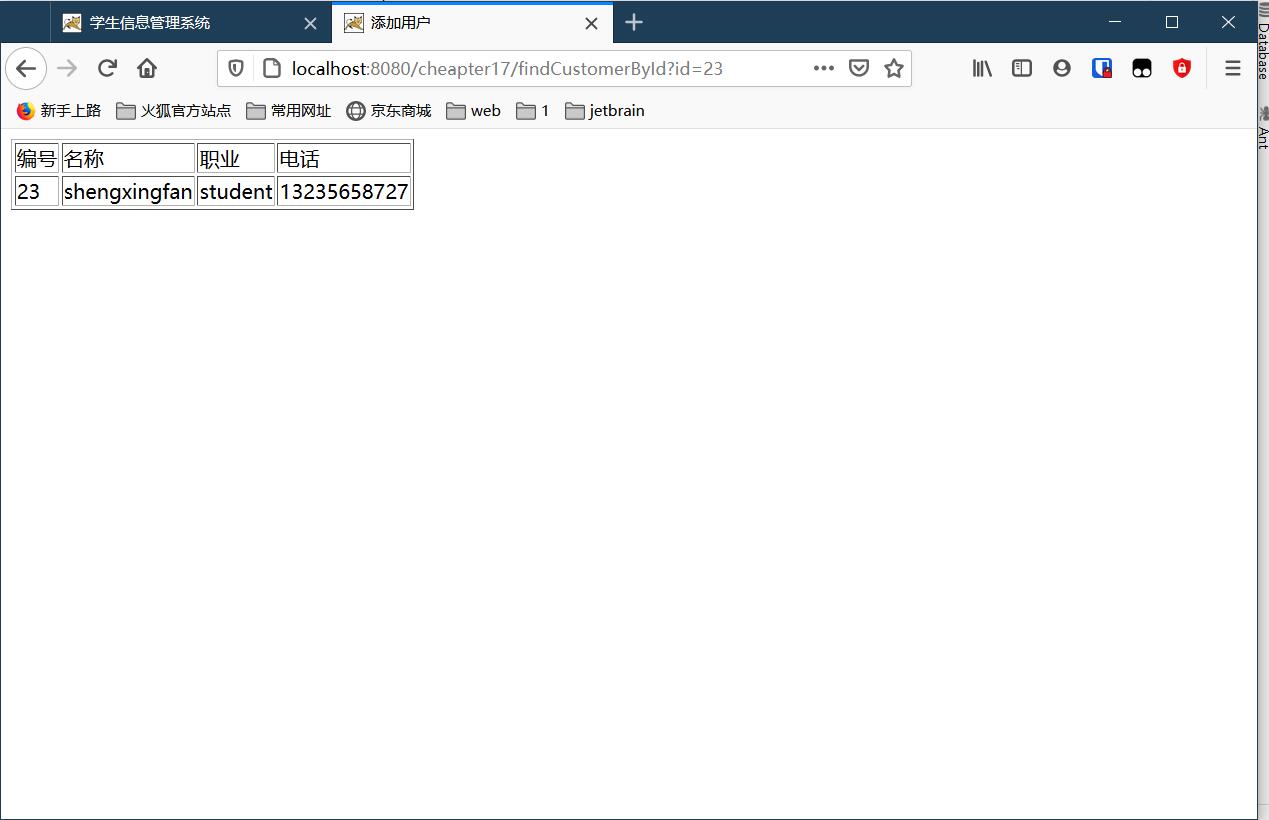5.pytest引數化使用
阿新 • • 發佈:2020-12-14
JavaEE專案實現
1.在專案的src目錄下建立log4j.properties檔案。
log4j.rootLogger=ERROR, stdout
log4j.logger.com.itheima=DEBUG
log4j.appender.stdout=org.apache.log4j.ConsoleAppender
log4j.appender.stdout.layout=org.apache.log4j.PatternLayout
log4j.appender.stdout.layout.ConversionPattern=%5p [%t] - %m%n
2.在src目錄下建立db.properties 檔案。編寫資料庫相關屬性和對應值。
jdbc.driver=com.mysql.jdbc.Driver
jdbc.url=jdbc:mysql://localhost:3306/mybatis
jdbc.username=root
jdbc.password=123456
jdbc.maxTotal=30
jdbc.maxIdle=10
jdbc.initialSize=5
3.在src目錄下,建立Spring的配置檔案applicationContext.xml.
<?xml version="1.0" encoding="UTF-8"?> <beans xmlns="http://www.springframework.org/schema/beans" xmlns:xsi="http://www.w3.org/2001/XMLSchema-instance" xmlns:aop="http://www.springframework.org/schema/aop" xmlns:tx="http://www.springframework.org/schema/tx" xmlns:context="http://www.springframework.org/schema/context" xsi:schemaLocation="http://www.springframework.org/schema/beans http://www.springframework.org/schema/beans/spring-beans-4.3.xsd http://www.springframework.org/schema/aop http://www.springframework.org/schema/aop/spring-aop-4.3.xsd http://www.springframework.org/schema/tx http://www.springframework.org/schema/tx/spring-tx-4.3.xsd http://www.springframework.org/schema/context http://www.springframework.org/schema/context/spring-context-4.3.xsd " > <!-- 讀取db.properties檔案 --> <context:property-placeholder location="classpath:db.properties"/> <!-- 配置資料來源 --> <bean id="dataSource" class="org.apache.commons.dbcp2.BasicDataSource"> <property name="driverClassName" value="${jdbc.driver}"></property> <property name="url" value="${jdbc.url}"></property> <property name="username" value="${jdbc.username}"></property> <property name="password" value="${jdbc.password}"></property> <property name="maxTotal" value="${jdbc.maxTotal}"></property> <property name="maxIdle" value="${jdbc.maxIdle}"></property> <property name="initialSize" value="${jdbc.initialSize}"></property> </bean> <!-- 事物管理器 依賴於資料來源 --> <bean id="transactionManager" class="org.springframework.jdbc.datasource.DataSourceTransactionManager"> <property name="dataSource" ref="dataSource"></property> </bean> <!-- 開啟事物註解 --> <tx:annotation-driven transaction-manager="transactionManager"/> <!-- 配置mybatis工廠 --> <bean id="sqlSessionFactory" class="org.mybatis.spring.SqlSessionFactoryBean"> <property name="dataSource" ref="dataSource"></property> <!-- 指定核心配置檔案位置 --> <property name="configLocation" value="classpath:mybatis-config.xml"></property> </bean> <bean class="org.mybatis.spring.mapper.MapperScannerConfigurer"> <property name="basePackage" value="com.itheima.dao"></property> </bean> <!-- 掃描Service --> <context:component-scan base-package="com.itheima.service"></context:component-scan> </beans>
4.在src目錄下,建立MyBatis的核心配置檔案mybatis-config.xml.
<?xml version="1.0" encoding="UTF-8"?> <!DOCTYPE configuration PUBLIC "-//mybatis.org//DTD Config 3.0//EN" "http://mybatis.org/dtd/mybatis-3-config.dtd"> <configuration> <!-- 配置別名 --> <typeAliases> <package name="com.itheima.po"/> </typeAliases> </configuration
5.src目錄下,建立SpringMVC的配置檔案springmvc-config.xml,宣告中引入spring-context,使用context:component-scan元素指定需要的類包。
<?xml version="1.0" encoding="UTF-8"?>
<beans xmlns="http://www.springframework.org/schema/beans"
xmlns:xsi="http://www.w3.org/2001/XMLSchema-instance"
xmlns:context="http://www.springframework.org/schema/context"
xsi:schemaLocation="http://www.springframework.org/schema/beans
http://www.springframework.org/schema/beans/spring-beans-4.3.xsd
http://www.springframework.org/schema/context
http://www.springframework.org/schema/context/spring-context-4.3.xsd
">
<context:component-scan base-package="com.itheima.controller"></context:component-scan>
</beans>
6.修改web.xml,在檔案配置SpringMVC前端控制器DispatcherServlet.
<!-- 配置載入Spring的配置檔案 通過監聽器實現的-->
<context-param>
<param-name>contextConfigLocation</param-name>
<param-value>classpath:applicationContext.xml</param-value>
</context-param>
<listener>
<listener-class>org.springframework.web.context.ContextLoaderListener</listener-class>
</listener>
<!-- 配置springmvc前置核心控制器 -->
<servlet>
<servlet-name>springmvc</servlet-name>
<servlet-class>org.springframework.web.servlet.DispatcherServlet</servlet-class>
<init-param>
<param-name>contextConfigLocation</param-name>
<param-value>classpath:springmvc-config.xml</param-value>
</init-param>
</servlet>
<servlet-mapping>
<servlet-name>springmvc</servlet-name>
<url-pattern>/</url-pattern>
</servlet-mapping>
7.在src目錄下,建立一個com.itheima.po包,在該包下建立持久化類Customer,編寫屬性和屬性的set/get方法。
package com.itheima.po;
public class Customer {
private Integer id;
private String username;
private String jobs;
private String phone;
public Integer getId() {
return id;
}
public void setId(Integer id) {
this.id = id;
}
public String getUsername() {
return username;
}
public void setUsername(String username) {
this.username = username;
}
public String getJobs() {
return jobs;
}
public void setJobs(String jobs) {
this.jobs = jobs;
}
public String getPhone() {
return phone;
}
public void setPhone(String phone) {
this.phone = phone;
}
@Override
public String toString() {
return "Customer [id=" + id + ", username=" + username + ", jobs=" + jobs + ", phone=" + phone + "]";
}
}
8.在src目錄下,建立一個com.itheima.dao包,並在包中建立介面CustomerDao和CustomerDao.xml。在CustomerDao.java中編寫public Customer findCustomerById(Integer id)抽象方法,在CustomerDao.xml中編寫實現該方法的SQL語句
package com.itheima.dao;
import com.itheima.po.Customer;
public interface CustomerDao {
public Customer findCustomerById(Integer id);
}
<?xml version="1.0" encoding="UTF-8"?>
<!DOCTYPE mapper
PUBLIC "-//mybatis.org//DTD Mapper 3.0//EN"
"http://mybatis.org/dtd/mybatis-3-mapper.dtd">
<mapper namespace="com.itheima.dao.CustomerDao">
<select id="findCustomerById" parameterType="Integer" resultType="customer">
select * from t_customer where id=#{id}
</select>
</mapper>
9.在src目錄下,建立一個com.itheima.service包,並在包中建立介面CustomerService和CustomerServiceImp實現類。在CustomerService.java中編寫public Customer findCustomerById(Integer id)抽象方法,在CustomerServiceImp.java中實現該抽象方法
public interface CustomerService{
public Customer findCustomerById(Integer id);
}
CustomerServiceImp.java
@Service
public class CustomerServiceImp implements CustomerService {
@Autowired
private CustomerDao customerDao;
public Customer findCustomerById(Integer id) {
return this.customerDao.findCustomerById(id);
}
}
10.在src目錄下,建立一個com.itheima.controller包,在包下建立CustomerController類,在類中新增到findCustomerById方法,並通過@RequestMapping註解該方
@Controller
public class CustomerController {
@Autowired
private CustomerService customerService;
/**
*根據id查詢客戶資訊
*/
@RequestMapping("/findCustomerById")
public String findCustomerById(Integer id,Model model) {
Customer customer =customerService.findCustomerById(id);
model.addAttribute("customer", customer);
//返回客戶資訊展示頁面
return "customer";
}
}
11在Web-INF目錄下,建立名為jsp的資料夾,然後在檔案中建立customer.jsp頁面。
<%@ page language="java" contentType="text/html; charset=UTF-8"
pageEncoding="UTF-8"%>
<!DOCTYPE html>
<html>
<head>
<meta charset="=UTF-8">
<title>新增使用者</title>
</head>
<body>
<table border="1">
<tr>
<td>編號</td>
<td>名稱</td>
<td>職業</td>
<td>電話</td>
</tr>
<tr>
<td>${customer.id}</td>
<td>${customer.username}</td>
<td>${customer.jobs}</td>
<td>${customer.phone}</td>
</tr>
</table></body>
</html>
